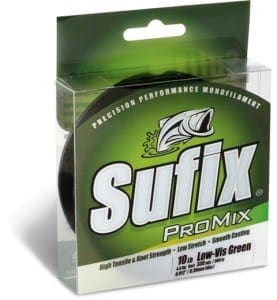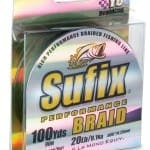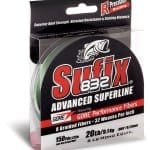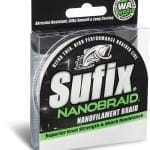Spooling up with fresh line is a great way to boost your odds of boating more bass. But with so many options on the market, choosing which one to use can seem harder than pulling a 10-pounder out of your livewell by the tail.
Lifelong bass junkie and Rapala’s director of field promotions Mark Fisher simplifies the selection process by tailoring his lines to the task at hand, the following are a few of Fisher’s thoughts on finding a winning line for any bassin’ situation.
“Let’s break it down by style of line,” he begins. “Monofilament, fluorocarbon and super braid.
“Nylon monofilament has been around for years, and many people today blow right past it in their search for a better line,” he continues. “But it’s come a long way and still has a place at the table.”
In a nutshell, mono is an inexpensive, all-around bass catcher. It casts well and is easy to handle, absorbs sudden shock and because of its stretch is more forgiving than other types of line when you set the hook like you’re swinging for the fences, or when a big bass goes berserk at boatside.
Fisher favors Sufix lines, and says the company offers three basic monos. “Elite is the supplest, with good knot strength and handling characteristics,” he says. “Siege is more abrasion resistant, with knot and shock strength for hard hooksets. Both Elite and Siege are great lines, but the third option, ProMix, is my longtime favorite.

“While some monofilaments force you to tender tradeoffs between different characteristics, ProMix has it all,” he adds. “It handles extremely well, is unbelievably abrasion resistant for fishing around vegetation, docks, woody cover and rocks, plus it has great shock and knot strength.”
Another benefit of a top-shelf mono like ProMix, Fisher points out, is how well-behaved it is on the reel. “It lies nicely on the spool of spinning and casting reels, even narrow-spool models that can give you fits with stiffer fluorocarbons jumping off of them,” he explains.
While mono has many applications in the bass world, Fisher says 8- to 14-pound test ProMix is his choice for open-water presentations such as cranking and jerkbait fishing.
Fluoro Factor
After first proving itself as stiff yet sturdy and virtually invisible saltwater leader material, fluorocarbon has gained favor as a mainline in many freshwater arenas, including bass fishing.
Along with being hard for fish to see, Fluoro is sensitive and strong. It’s also more resistant to abrasion and damage from the sun’s UV rays than ordinary mono of the same diameter. And unlike mono, it doesn’t absorb water, so you enjoy the same performance from your line throughout a trip.
Low-end stretch is also less than mono, so Fluoro is a fine choice whenever you need to set the hook at the end of a long cast.
“Overall, fluorocarbon has a few tradeoffs including being less manageable than mono, having less shock strength and sinking faster than mono,” Fisher notes. “And if you tighten a knot without wetting the line, you’re asking for trouble. But a well-tied and lubed Palomar or other Fluoro-friendly knot yields great knot strength.”
Fisher throws Fluoro with a number of different presentations. “I use it for flipping jigs, casting spinnerbaits or jerkbaits, and anytime I don’t want a lot of stretch,” he says. “As a caveat, make sure the rods you pair with fluorocarbon are forgiving, because you don’t want to overpower a low-stretch line.”
Fluorocarbon is available as leader material and in spoolable options. Fisher prefers the latter, particularly Sufix Castable Invisiline 100% Fluorocarbon.
Superline Savvy
Thin, strong and low-stretch braided superlines took the bass market by storm a number of years ago. Many anglers thought they would totally replace mono, but in the end there was plenty of room for both styles, along with fluorocarbons.
“Super braids were originally touted as the cure-all for crummy old monos that everyone had problems with when you went to heavier pound tests,” says Fisher. “But braid wasn’t perfect, and mono evolved and survived.
“Superline benefits include amazing sensitivity and great strength even at extremely thin diameters,” he says. “Tradeoffs include high visibility, a tendency to fade, the poorest shock strength of all three line styles, slippage with some knots, and a propensity to backlash with a vengeance.”
Fisher leans on braid in various situations. “It’s great for hand-to-hand combat with big bass in thick vegetation,” he reports. “I also use it for finesse fishing in open water.”
Fisher recommends a trio of Sufix superlines.

“Performance Braid is a down-and-dirty performer that’s quiet, easy to handle and casts a country mile,” he says. “Because it sinks, unlike many other braids, bass anglers have gravitated to it for times they want to keep the nose of the bait down, such as when you’re fishing frogs.”

He also likes Sufix 832 Advanced Superline. “832 blends seven strands of Dyneema with a single GORE Performance Fiber to enhance casting distance and accuracy, abrasion resistance, strength and sensitivity,” he says. “I use it for all of my vertical jigging, plus pitching, flipping and jig worming. Use it with a fluorocarbon leader for low visibility or tie direct when that’s not an issue.”

Last but not least comes Sufix NanoBraid. “About the time you think you have the line game all figured out, Sufix releases this tightly woven nano-filament that’s the smoothest casting braid I’ve ever seen,” he says. “So while it’s notably strong, abrasion resistant and sensitive, the gains in casting distance and accuracy really stand out.”
Fisher recommends pairing NanoBraid with spinning gear and using it for drop-shotting and light jig applications. “It excels for casting 1/16-ounce marabou jigs for smallmouths, swimming small boot-tail grubs, and basically any finesse presentation,” he says.
Personal Taste
While each one of today’s high-performance bass fishing lines has its strong suits, at the end of the day, Fisher says the best line for the job is still the one you’re the most comfortable with and confident using.
“Experiment with different options for different presentations to find out what works for your styles of fishing,” he offers. “In the end, that’s the best way to find the right line for every situation.”
















